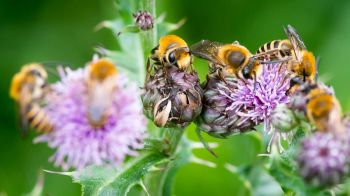News
Research demonstrates high value 'injurious weeds' can bring to pollinators and biodiversity
By: Stephanie Allen
Last updated: Tuesday, 8 March 2022

Ivy bees visiting creeping thistle © Allan Burrows
A new study by researchers at the University of Sussex, funded by Rowse Honey Ltd, has demonstrated that weeds are far more valuable in supporting biodiversity than we give them credit for.
Dr Nicholas Balfour and Professor Francis Ratnieks compared the biodiversity value of plants classified as ‘injurious weeds’ with those stipulated by the Department for Environment, Food and Rural Affairs (DEFRA) for pollinator targeted agri-environmental options, such as red clover and wild marjoram.
Their findings, published in the Journal of Applied Ecology, show that the abundance and diversity of pollinators visiting weed species are far higher than DEFRA recommended plants.
In the UK, five species of native wildflowers are classified as “injurious” in the 1959 Weeds Act. Three of them are frequently visited by many species of bees and other insects - ragwort (Jacobaea vulgaris) and two thistles (Cirsium arvense, C. vulgare). The other two are docks (Rumex crispus and R. obtusifolius), whose flowers are mainly wind-pollinated.
Dr Balfour and Professor Ratnieks conducted a field study in East Sussex where they quantified and identified insects visiting three of these species - the flowers of ragwort, thistles, and other wildflowers, including those recommended by DEFRA - growing in six pasture or ex-pasture sites.
Their results, which found that pollinators were visiting weed species in higher numbers than DEFRA recommended plants, were mirrored by a subsequent analysis of scientific literature.
In the Database of Pollinator Interactions, four times as many pollinator species and five times more conservation-listed species have been recorded visiting the three insect-pollinated weeds. Of the 387 plant species analysed in the database, in terms of pollinator species recorded, the weeds were ranked 4th (C. arvense), 6th (J. vulgaris), and 13th (C. vulgare). Similarly, the Database of Insects and their Food Plantsshowed that twice as many herbivorous insect species are associated with the five weed species.
Dr Nicholas Balfour, Post-Doctoral Researcher at the Laboratory of Apiculture and Social Insects (LASI) at the University of Sussex, said: “There now exists a substantial body of evidence which shows that weeds are a vitally important resource for pollinators.
“The three insect-pollinated species have open flowers that allow access to a wide variety of pollinator species, and they produce, on average, four times more nectar sugar than the DEFRA recommended plant species.
“Pollinators are crucial to maintaining global biodiversity, ecosystem resilience and agricultural output. However, there are significant concerns about pollinator declines and the long-term decline of flowers in our landscapes is considered a key factor.
“We appreciate that agricultural weeds can cause yield losses in arable and pastureland. However, we’ve shown that they can also be of great value to both flower-visiting and herbivorous insects – and shouldn’t be underestimated when it comes to supporting our natural biodiversity.”
Freedom of information requests to public bodies such as councils, Natural England and Highways England indicated that circa £10 million per year is spent controlling injurious weeds.
The majority of local councils indicated that they actively control ragwort, thus classing it in the same bracket as invasive, non-native species such as Japanese knotweed (Reynoutria japonica), likely due to the Ragwort Control Bill 2003.
Dr Balfour added: “It is alarming that the many public bodies are using tax-payers’ money and volunteers to actively remove ragwort. This plant was found to support the most conservation-listed insect species in our study.
“The implementation of the Ragwort Control Bill probably deserves greater scrutiny, especially given that the evidence underpinning it is questionable.
“Our results clearly show that weeds have an underappreciated value in supporting our natural biodiversity. Unfortunately, current UK agricultural policy encourages neither landsparing for, nor landsharing with, weeds.”
Francis Ratnieks, Professor of Apiculture at the Laboratory of Apiculture and Social Insects (LASI) at the University of Sussex said: “Many common native plant species valuable to wildlife conservation are, unfortunately, underappreciated. Here we show the importance of ragwort and thistles to flower-visiting insects. Previously LASI has shown the importance of bramble and ivy, plants which are often referred to in negative terms such as thugs or parasites.”
The authors are now calling for policymakers to take another look at how existing policies are implemented and reconsider the role of weeds in future agri-environmental policy. The Environmental Land Management Scheme, which is to be rolled out for English farmers by the end of 2024, will largely replace the schemes currently available under the EU Common Agricultural Policy. The authors are hopeful that this policy will provide sufficient directives and financial incentives to persuade land managers to tolerate injurious weeds, while taking into account the challenges facing different stakeholders and the balance of practicality and cost, as well as the benefits to the natural world of tolerating weeds.

